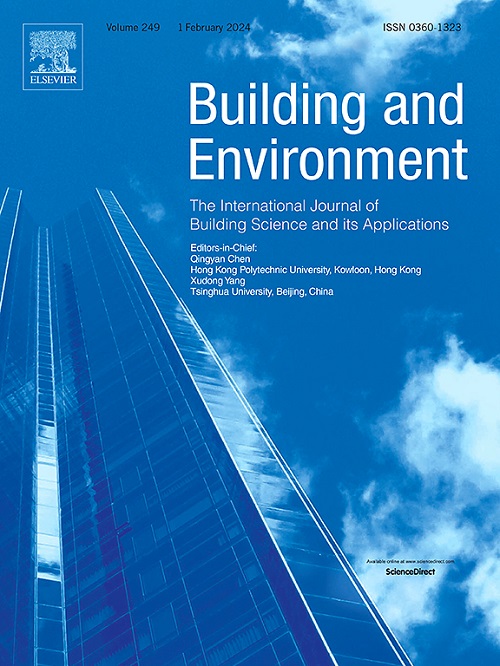交通噪音对大学生心理生理反应的影响:脑电图研究
IF 7.1
1区 工程技术
Q1 CONSTRUCTION & BUILDING TECHNOLOGY
引用次数: 0
摘要
交通噪声危害公众健康,但其具体机制尚不完全清楚。为了了解不同声压级(SPL)的交通噪声如何影响心理生理反应,本研究考察了五种声压级的交通噪声:40、45、50、55 和 60 dB。研究人员招募了 38 名年轻大学生,对他们进行了情绪状态档案 (POMS) 评估,并测量了心电图和脑电图。研究发现,与无声相比,暴露于交通噪声会导致情绪紊乱增加 0.95-1.64 倍,与其他声压级相比,60 分贝交通噪声导致的情绪紊乱增加幅度更大。随着声压级的增加,ΔLF/HF 增加了 0.01-0.83,表明压力水平升高。交通噪音也会引起大脑的应激反应,与无声相比,α 功率降低了 13.08-24.15%。高声压级交通噪音会严重损害大脑的舒适度。与 40-45 分贝相比,暴露于 50-60 分贝的交通噪声会使 α 功率显著增加 28.66-85.80 %(p < 0.05)。此外,与无声相比,60 分贝的交通噪声使大脑超临界活动的可能性增加了 32.49%。心理反应变化与生理反应变化密切相关。Δα功率,尤其是额叶和顶叶的Δα功率,是预测总情绪障碍增加的最强指标,这表明这些脑叶应该是未来交通噪声-大脑研究的重点。这项研究强调了从心理生理学角度全面评估交通噪声负面影响的必要性,并突出强调了高声压级的危害。研究结果为制定室内声学环境标准提供了宝贵的见解。本文章由计算机程序翻译,如有差异,请以英文原文为准。
Effects of traffic noise on the psychophysiological responses of college students: An EEG study
Traffic noise harms public health, but the specific mechanisms are not fully understood. To understand how traffic noise at different sound pressure levels (SPLs) affects psychophysiological responses, this study examined five SPLs of traffic noise: 40, 45, 50, 55, and 60 dB. 38 young college students were recruited for Profile of Mood States (POMS) evaluations and measurements of electrocardiogram and electroencephalogram. The study found that traffic noise exposure led to a 0.95–1.64-fold increase in mood disturbance compared to no sound, with 60 dB traffic noise causing a significantly greater increase compared to other SPLs. As SPL increased, ΔLF/HF increased by 0.01–0.83, indicating heightened stress levels. Traffic noise also induced stress responses in the brain, with α power reduced by 13.08–24.15 % compared to no sound. High SPL traffic noise significantly harmed brain comfort. Compared to 40–45 dB, exposure to 50–60 dB traffic noise significantly increased α power by 28.66–85.80 % (p < 0.05). Additionally, 60 dB traffic noise increased the likelihood of supercritical brain activity by 32.49 % compared to no sound. Psychological response changes were closely related to physiological response changes. Δα power, particularly in the frontal and parietal lobes, was the strongest predictor of the increase in total mood disturbance, suggesting these lobes should be the focus of future traffic noise-brain studies. The study emphasizes the need for a comprehensive evaluation of the negative effects of traffic noise from a psychophysiological perspective, highlighting the harm of high SPLs. The findings provide valuable insights for developing indoor acoustic environment standards.
求助全文
通过发布文献求助,成功后即可免费获取论文全文。
去求助
来源期刊

Building and Environment
工程技术-工程:环境
CiteScore
12.50
自引率
23.00%
发文量
1130
审稿时长
27 days
期刊介绍:
Building and Environment, an international journal, is dedicated to publishing original research papers, comprehensive review articles, editorials, and short communications in the fields of building science, urban physics, and human interaction with the indoor and outdoor built environment. The journal emphasizes innovative technologies and knowledge verified through measurement and analysis. It covers environmental performance across various spatial scales, from cities and communities to buildings and systems, fostering collaborative, multi-disciplinary research with broader significance.
 求助内容:
求助内容: 应助结果提醒方式:
应助结果提醒方式:


